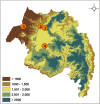Anopheles cinereus implicated as a vector of malaria transmission in the highlands of north-west Ethiopia
- PMID: 31767025
- PMCID: PMC6878634
- DOI: 10.1186/s13071-019-3797-9
Anopheles cinereus implicated as a vector of malaria transmission in the highlands of north-west Ethiopia
Abstract
Background: Transmission of malaria in the highlands of Ethiopia is poorly understood and usually attributed to importation by mobile populations or local transmission by Anopheles arabiensis. To characterize and identify Anopheles species present in a highland area of northern Ethiopia, adult and larval collections were performed in Gondar town and the neighboring Senbet Debir village (Dembia district, > 2000 meters above sea level, masl), in addition to Bahir Dar town (capital of Amhara region) and Kumer Aftit village (Metema district, < 2000 masl).
Methods: CDC-light traps were used to collect adult mosquitoes and larval collections were performed from rain pools for rearing into adults for species identification. Collections were made September-March 2016-2018. Adult mosquitoes were identified morphologically and a subset of randomly chosen specimens were identified to species by sequencing the ribosomal DNA internal transcribed spacer region 2 (ITS2) and mitochondrial DNA cytochrome c oxidase subunit 1 (cox1).
Results: The primary species of Anopheles identified at elevations higher than 2000 masl was An. cinereus, which was confirmed molecularly by ITS2 and cox1 sequencing. Interestingly, two unknown species were also sequenced, in addition to two specimens of An. pretoriensis. The species collected at sites with elevations less than 2000 masl (Bahir Dar town and Kumer Aftit village) was An. arabiensis. Three Plasmodium falciparum-positive specimens were identified molecularly as An. cinereus.
Conclusions: The presence of Plasmodium-positive An. cinereus in areas greater than 2000 masl incriminates this species as a potential vector contributing to non-peak malaria transmission in Ethiopian highland areas.
Keywords: Anopheles; Ethiopia; Malaria; Residual transmission.
Conflict of interest statement
The authors declare that they have no competing interests.
Figures
Similar articles
-
Systematic review of sporozoite infection rate of Anopheles mosquitoes in Ethiopia, 2001-2021.Parasit Vectors. 2023 Nov 27;16(1):437. doi: 10.1186/s13071-023-06054-y. Parasit Vectors. 2023. PMID: 38008761 Free PMC article. Review.
-
Bionomic characterization of Anopheles mosquitoes in the Ethiopian highlands and lowlands.Parasit Vectors. 2024 Jul 16;17(1):306. doi: 10.1186/s13071-024-06378-3. Parasit Vectors. 2024. PMID: 39014474 Free PMC article.
-
Variation in species composition and infection rates of Anopheles mosquitoes at different altitudinal transects, and the risk of malaria in the highland of Dirashe Woreda, south Ethiopia.Parasit Vectors. 2017 Jul 19;10(1):343. doi: 10.1186/s13071-017-2288-0. Parasit Vectors. 2017. PMID: 28724450 Free PMC article.
-
Vectorial drivers of malaria transmission in Jabi Tehnan district, Amhara Regional State, Ethiopia.Sci Rep. 2024 Jun 13;14(1):13669. doi: 10.1038/s41598-024-64436-3. Sci Rep. 2024. PMID: 38871839 Free PMC article.
-
Malaria Vectors and Species Complexes in Thailand: Implications for Vector Control.Trends Parasitol. 2019 Jul;35(7):544-558. doi: 10.1016/j.pt.2019.04.013. Epub 2019 Jun 7. Trends Parasitol. 2019. PMID: 31182384 Review.
Cited by
-
Remote sensing of environmental risk factors for malaria in different geographic contexts.Int J Health Geogr. 2021 Jun 13;20(1):28. doi: 10.1186/s12942-021-00282-0. Int J Health Geogr. 2021. PMID: 34120599 Free PMC article.
-
Impact of high malaria incidence in seasonal migrant and permanent adult male laborers in mechanized agricultural farms in Metema - Humera lowlands on malaria elimination program in Ethiopia.BMC Public Health. 2020 Mar 12;20(1):320. doi: 10.1186/s12889-020-8415-4. BMC Public Health. 2020. PMID: 32164610 Free PMC article.
-
Population travel increases the risk of Plasmodium falciparum infection in the highland population of Gardula Zone, South Ethiopia: A longitudinal study.PLoS One. 2024 Dec 20;19(12):e0315900. doi: 10.1371/journal.pone.0315900. eCollection 2024. PLoS One. 2024. PMID: 39705289 Free PMC article.
-
Species composition, infection rate and feeding preference of Anopheles mosquito species (Diptera: Culicidae) in the west Amhara Region, northwest Ethiopia.PLoS One. 2024 Jul 25;19(7):e0307063. doi: 10.1371/journal.pone.0307063. eCollection 2024. PLoS One. 2024. PMID: 39052655 Free PMC article.
-
Systematic review of sporozoite infection rate of Anopheles mosquitoes in Ethiopia, 2001-2021.Parasit Vectors. 2023 Nov 27;16(1):437. doi: 10.1186/s13071-023-06054-y. Parasit Vectors. 2023. PMID: 38008761 Free PMC article. Review.
References
-
- Hurni H. Degradation and conservation of soil resources in the Ethiopian highlands. In: Hurni H, Messerli B, editors. African mountains and highlands: problems and perspectives. Missouri: Wadsworth Press; 1990. pp. 51–63.
-
- Tilaye T, Deressa W. Prevalence of urban malaria and assocated factors in Gondar Town, Northwest Ethiopia. Ethiop Med J. 2007;45(2):151–158. - PubMed
MeSH terms
LinkOut - more resources
Full Text Sources
Medical


